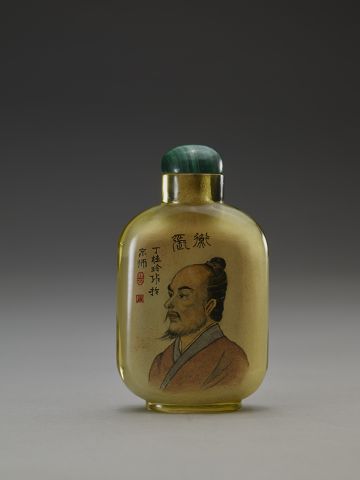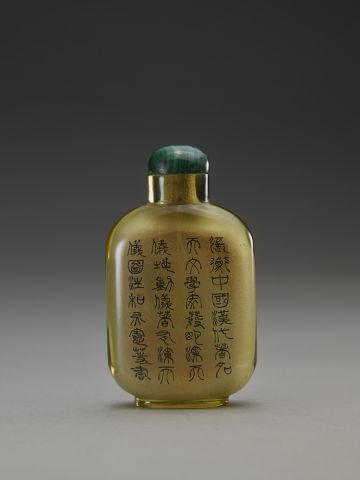

Bottle ID: 730
DING GUILING, PORTRAIT OF ZHANG HENG
Date: Circa 1960
Height: 62 mm
Glass, of clear amber tone, of flattened, rectangular form with shoulders sloping to a cylindrical neck and with a neatly carved oval footrim, painted on the inside using ink and watercolors with on one main side a portrait of Zhang Heng; the reverse with a long inscription in archaic script, signed Ding Guiling, with two red seals.
Similar Examples:
Crane Collection no. 722
Moss, Hugh, Victor Graham and Ka Bo Tsang. A Treasury of Chinese Snuff Bottles. The Mary and George Bloch Collection. Hong Kong: Herald Intl., 2002, Volume 4, part 2, Inside Painted, pp. 594-595, no. 670 and pp. 596-597, no. 671
Provenance:
Albert Combatalade, CA.
Ed Combatalade, CA.
During the 1960s and 1970s in Beijing, four inside-painted artists were taught how to paint inside bottles by the Ye Family in a successful effort to continue the tradition started by Ye Zhongsan at the turn of the twentieth century. Two of those four artists were male - Wang Xisan (who subsequently moved to Hebei) and Liu Shouben. The other two were female - Ye Shuyin (the daughter of Ye Bengqi) and Ding Guiling. Sadly works by Ding Guiling are few and far between as she died at an early age.
Zhang Heng (78-139 AD) was born in Nanyang during the Eastern Han dynasty. He was a mathematician, astronomer, and geographer, and also a poet. He rose to the position of Chief Astrologer and Minister under the emperor An’ti. He had been born into an important family and was well-educated in political philosophy and literature. In his early thirties Zhang became interested in astronomy. In 116 AD he was appointed as an official at the emperor’s court. However, Zhang was not always suited to life at the court and spent periods on retreat away from the capital in order to write poetry and study astronomy. He first achieved fame as a poet and has had a lasting influence on Chinese culture. His works Si Chou Shi (Four Chapters of Distressed Poems) and Gui Tian Fu (To Live In Seclusion) are considered literary masterpieces. After Zhang became an expert in astronomy he was involved in calendar reform. In 132 AD he invented the first seismograph for measuring earthquakes. Zhang was also the first person in China to construct an equatorial armillary sphere, consisting of a system of rings corresponding to the great circles of the celestial sphere with a central tube which was used to line up stars and planets. With this instrument Zhang was able to make more accurate star maps than earlier Chinese astronomers.
< Back to full list

 English
English 中文
中文